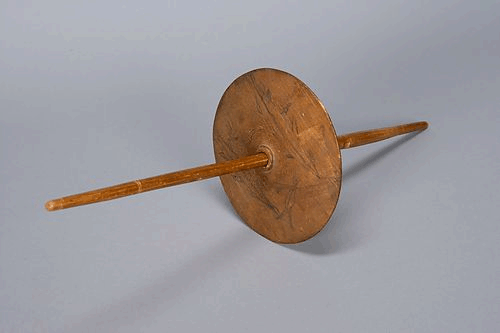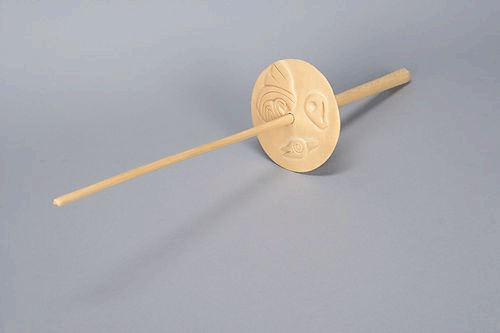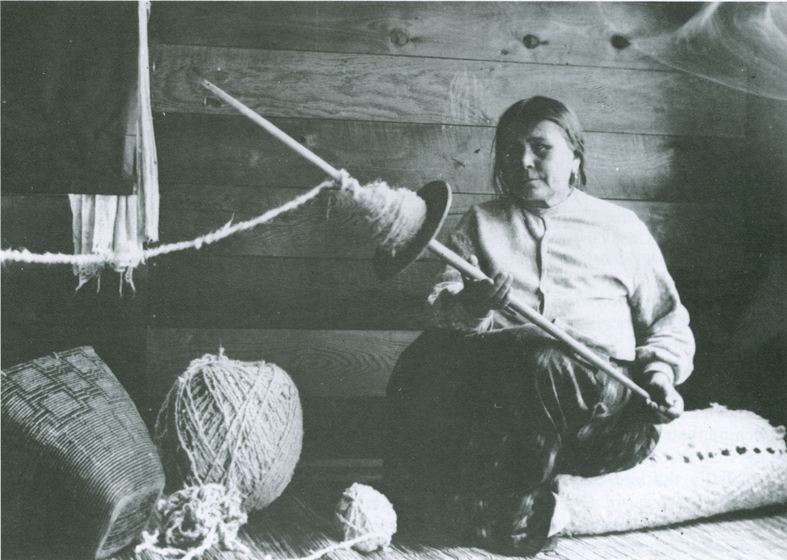Projects and Science
Canada
North America
ABT
The Coast Salish Spindle
The Coast Salish spindle was used mainly by the Coast Salish of Vancouver Island (e.g. Snuneymuxw , Quwutsun, Tsartlip) and the mainland Coast Salish (e.g. Musqueam, Sto’ lo, Semiahmoo). The Coast Salish Spindle is distinguished from other spindles, not only due to its size: the spindle shaft usually measures 90-120 cms / 35-48” and the whorl is commonly 18-20 cms / 7-8” (Buxton-Keenlyside, 1980, p. 29), but also due to its method of use –tossing into the air.
The whorl, often made from Maple wood, is placed either midway up the shaft or between half-way and two thirds down the shaft. The shaft is tapered with the larger end at the bottom. The whorl is often decorated by incised carving on one side of the whorl, the side facing down towards the spinner. The upper side of the whorl is sometimes flat or plated. On many whorls the center shaft hole is thicker than the surrounding wood, tapering down to a thinner outer edge.
According to Mary Kissell, an expert with the American Museum of Natural History and later an Associate Professor in the Home Economics department at Berkley, who with Dr Newcombe, visited and recorded the use of the spindle and described the method in an article in 1916 (Kissell, 1916), first a roving is made by hand spinning the fiber against the thigh. This roving is then put through a tension ring in the rafters or the upper frame of a loom and then down to the spindle:
“After proceeding through the tension ring or over the loom frame, the end of the roving is tightly twisted for a short distance between the palms and then attached to the upper arm of the spindle shaft near the whorl. Everything having been made ready, the spinner squats upon a mat on the floor and with outstretched arms raises the huge spindle to an oblique position by grasping its lower end in the palm of her left hand and clasping its shaft a little below the whorl in her right. The twirling might be termed a tossing motion which is performed by the up-turned palm of the right hand. When the roving has received the required amount of twist the upper end of the spindle is swung upward and backward, thus bringing the next draft of roving through the tension ring and permitting, after the spindle end is again dropped to position, that the loosely sagging and already twisted yarn be wound upon the spindle. This is accomplished by lacing the yarn back and forth in large oval coilings on the upper arm of the shaft as the spindle is lifted and lowered from the oblique to the vertical and from the vertical to the oblique while it is still revolving. After the stretch of completed yarn is wound on the shaft the spinner returns to the twirling motion that the freshly drawn roving may be twisted, when it is wound on the shaft as before described.”
The Salish spindle was used for spinning goat wool mixed with dog hair from the Salish Wool Dog. The yarn created was a thick yarn used for blankets. Later the spindle was used for yarns used in the Cowichan sweater industry.
Liz Kaarremaa, Vancouver Island University
Literature :
- Mary Lois Kissell, A New Type of Spinning in North America. In: American Anthropologist 18 (2), 1916, p. 264-270.
- Judith Buxton-Keenlyside, Selected Canadian spinning wheels in perspective: an analytical approach (Ottawa 1980).
- Paula Gustafson, Salish Weaving (Vancouver / Seattle 1980).
- Isa Loughran-Delahunt, A Functional Analysis of Northwest Coast Spindle Whorls. Master´s Thesis, Western Washington University (1996).
- Diane Elizabeth Keighley, "Almost lost but not forgotten": contemporary social uses of Central Coast Salish spindle whorls. Master´s Thesis, University of British Columbia (Vancouver 2000).

Coast Salish spindle, Quwutsun'. Before 1934.
© UBC Museum of Anthropology, Photographed by Kyla Bailey. CCL

Coast Salish spindle, Misqueam. Made by Ramsey Louis.
© UBC Museum of Anthropology, Photographed by Kyla Bailey. CCL

Coast Salish spindle, Quwutsun'. Before 1934.
© UBC Museum of Anthropology, Photographed by Kyla Bailey. CCL
These and more spindles and spindle whorls can be found at the Museum of Anthropology, University of British Colombia, in their online-collection.
